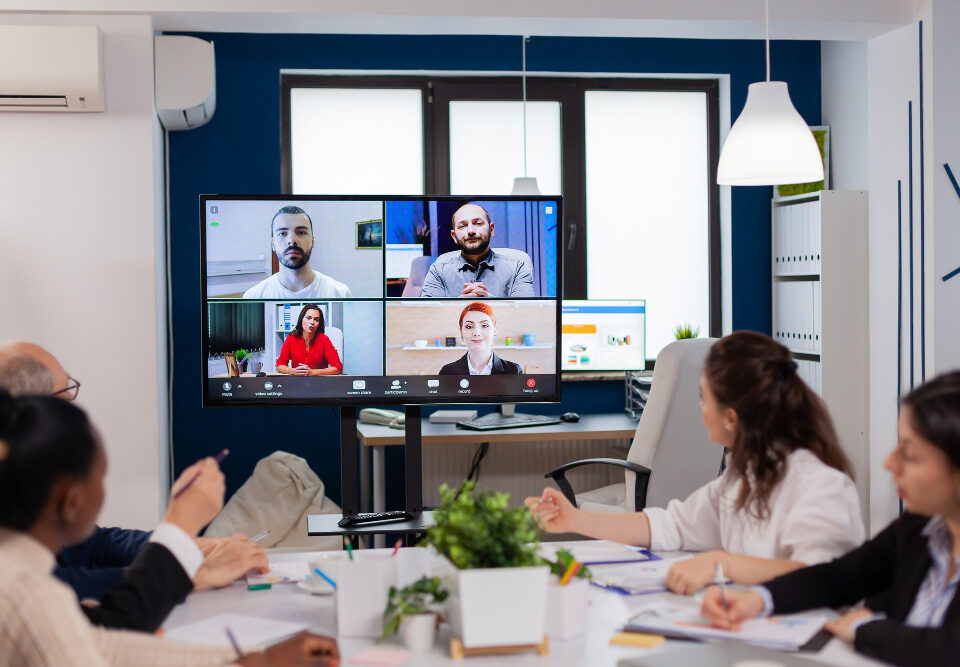- Have any questions?
- +971 4 88 733 70
- sales@datavoiz.com

Virtual Collaboration: The Core of Video Conference System
February 28, 2024
The Ultimate Guide To Mastering Video Conferencing Etiquette
March 4, 2024Introduction
In today’s fast-paced business landscape, the design of meeting room holds significant importance in fostering productivity and collaboration. A well-designed meeting room goes beyond aesthetics; it sets the stage for successful discussions and decision-making processes. In this article, we delve into the key elements essential for creating an ideal meeting room environment. From understanding the diverse needs of meetings to embracing advanced technology and incorporating nature-inspired elements, we explore how thoughtful design choices can transform ordinary meetings into dynamic and productive sessions.
Importance of a Well-Designed Meeting Room
A meticulously designed meeting room is pivotal for productivity and collaboration. It serves as a tangible representation of an organization’s commitment to excellence and innovation. By investing in a thoughtfully planned meeting room, you signal to your team and clients that their time and contributions are valued. The environment you create sets the tone for discussions, fostering creativity and engagement among participants.
Understanding the Needs of Different Meetings
Meeting rooms must cater to diverse meeting requirements. From vibrant, open spaces for brainstorming sessions to professional atmospheres for board meetings, tailoring the room to specific purposes enhances productivity and ensures successful outcomes. Embracing adaptability in meeting room design allows for seamless transitions between different meeting formats, ensuring participants feel comfortable and engaged throughout.
Space Planning for Comfort and Functionality
Space planning is crucial for comfort and functionality in meeting rooms. The layout should allow ample space for movement while strategically placing furniture and equipment to promote interaction. Incorporating versatile seating arrangements and emphasizing ergonomics enhances focus and attentiveness among participants.
Utilizing Natural Light and Proper Lighting
Natural light and adjustable lighting fixtures enhance mood and energy levels in meeting rooms. Strategic placement of windows and skylights illuminates the space, fostering creativity and engagement. Selecting Suitable Furniture and Layout: Ergonomic furniture and a well-thought-out layout promote comfort and functionality, enhancing collaboration and communication among participants.
Incorporating Technology for Efficiency
Technology integration streamlines communication and collaboration, fostering productivity. User-friendly video conferencing systems and smart automation features optimize the meeting experience, allowing participants to focus on the agenda without disruptions.
Enhancing Acoustics for Clear Communication
Sound dampening materials and strategic placement of furniture improve auditory clarity, promoting focused discussions. Sound masking technology enhances privacy and concentration, ensuring productive interactions.
Adding Greenery for a Refreshing Atmosphere
Green elements create a tranquil environment that inspires creativity and boosts productivity. Strategic placement of plants purifies the air and revitalizes the space, fostering a sense of renewal and growth.
Implementing Color Psychology for Productivity
Strategic use of colors influences mood and productivity in meeting rooms. Incorporating hues that promote calmness, creativity, and harmony creates a vibrant environment conducive to successful meetings.
Maintaining Cleanliness and Organization
An organized meeting room enhances efficiency and promotes clarity. Implementing storage solutions and encouraging cleanliness fosters a professional environment that supports productive discussions.
Creating a Welcoming Environment for Collaboration
Comfortable seating arrangements, natural elements, and personalized touches create a welcoming atmosphere that encourages collaboration and innovation. By curating a space that reflects the values and culture of the team, collaboration during meetings is enhanced.
Conclusion
In conclusion, the design of a meeting room significantly impacts the success and productivity of gatherings. By integrating elements such as natural light, advanced technology, and greenery, meeting rooms can foster innovation and collaboration. Remember, a well-designed meeting room is more than just a space—it is a catalyst for creativity and synergy, driving the achievement of organizational goals.
For more info:





